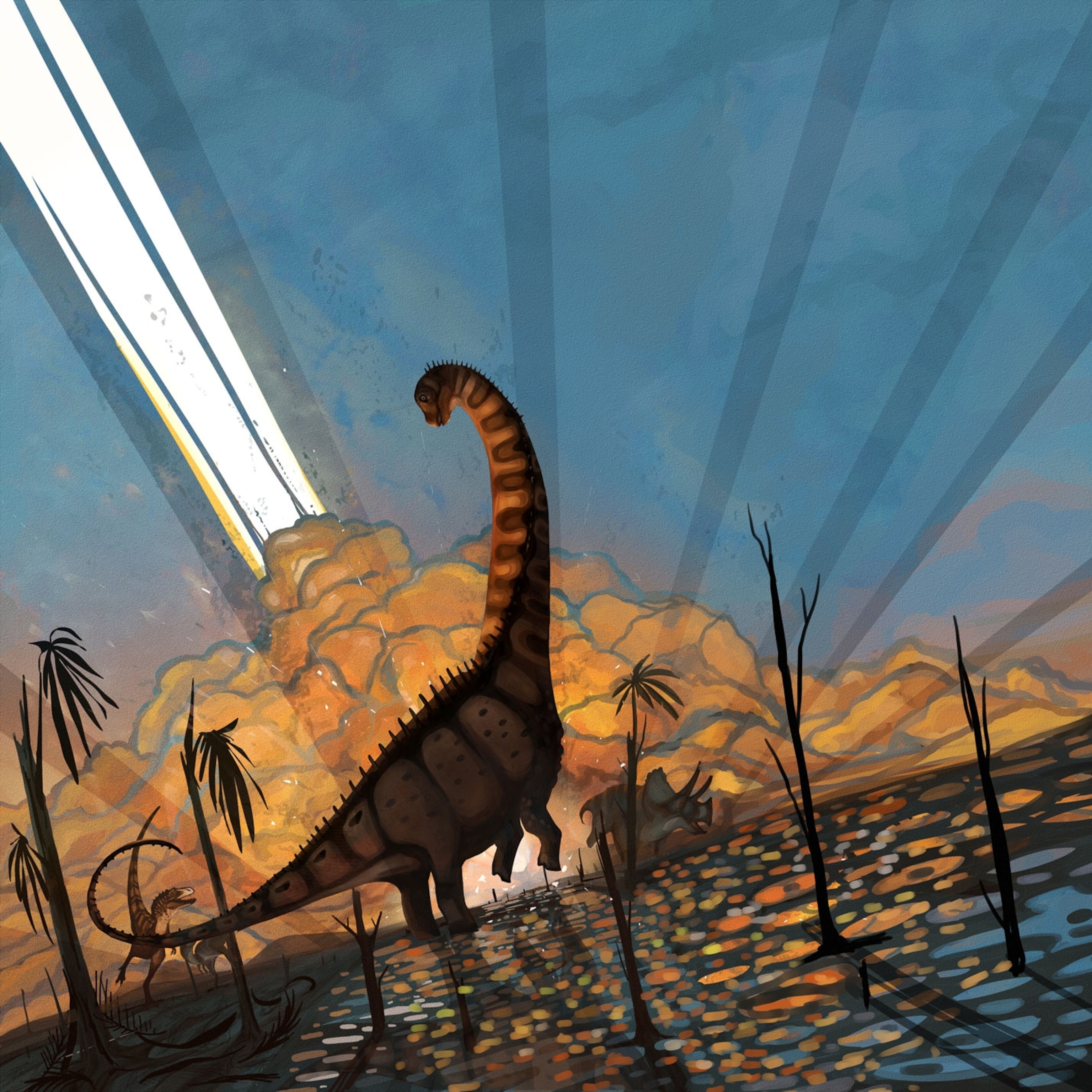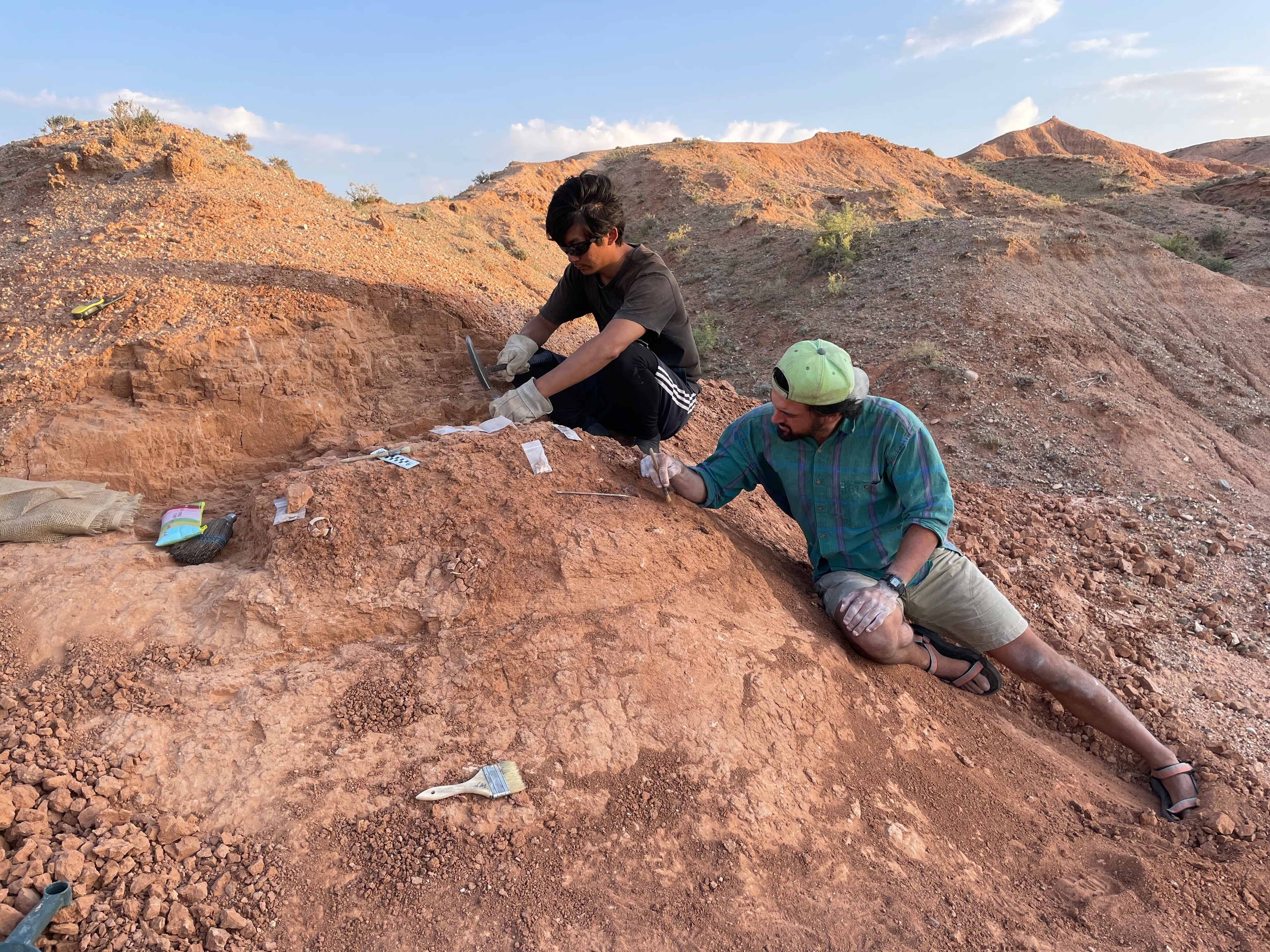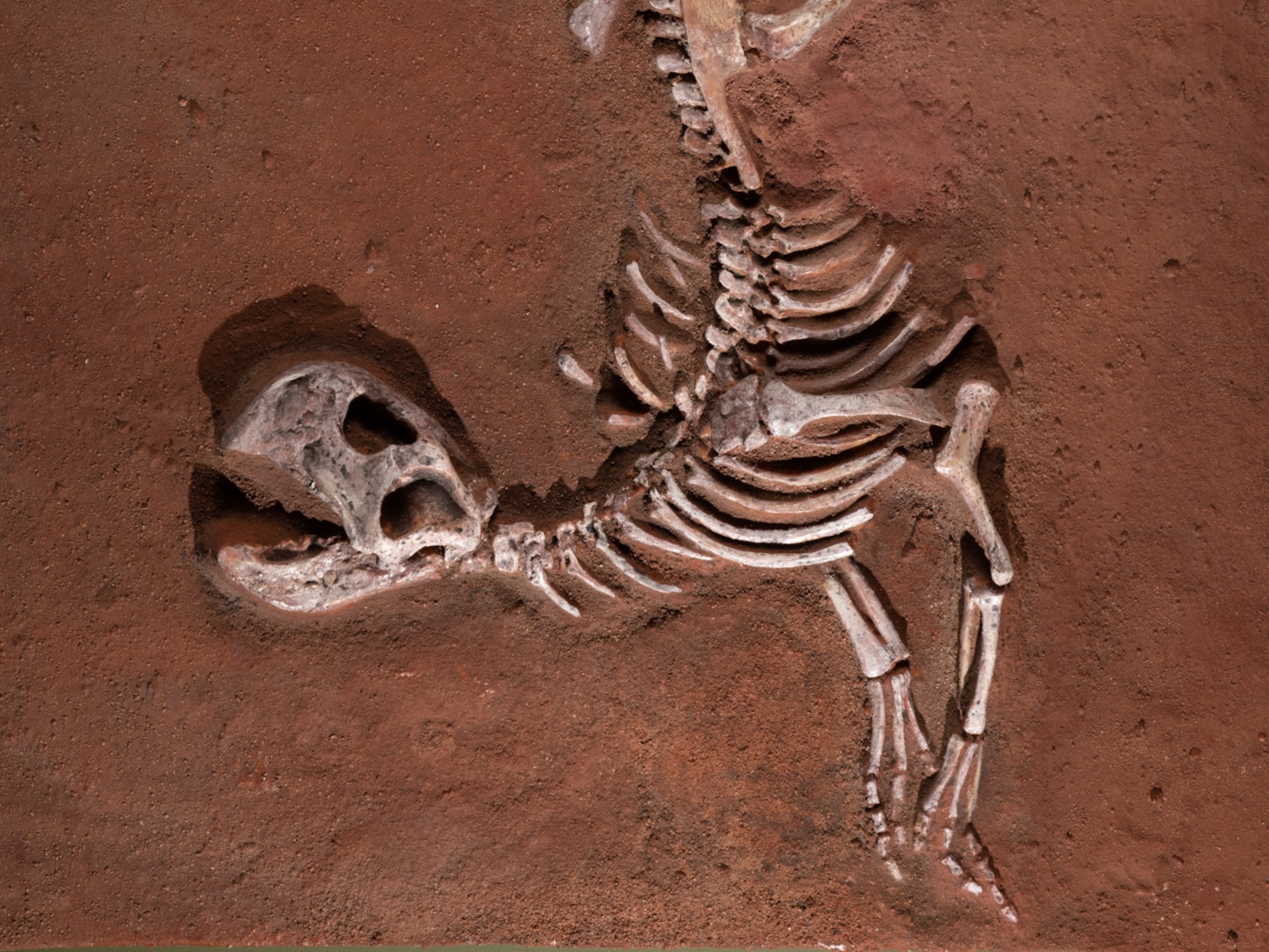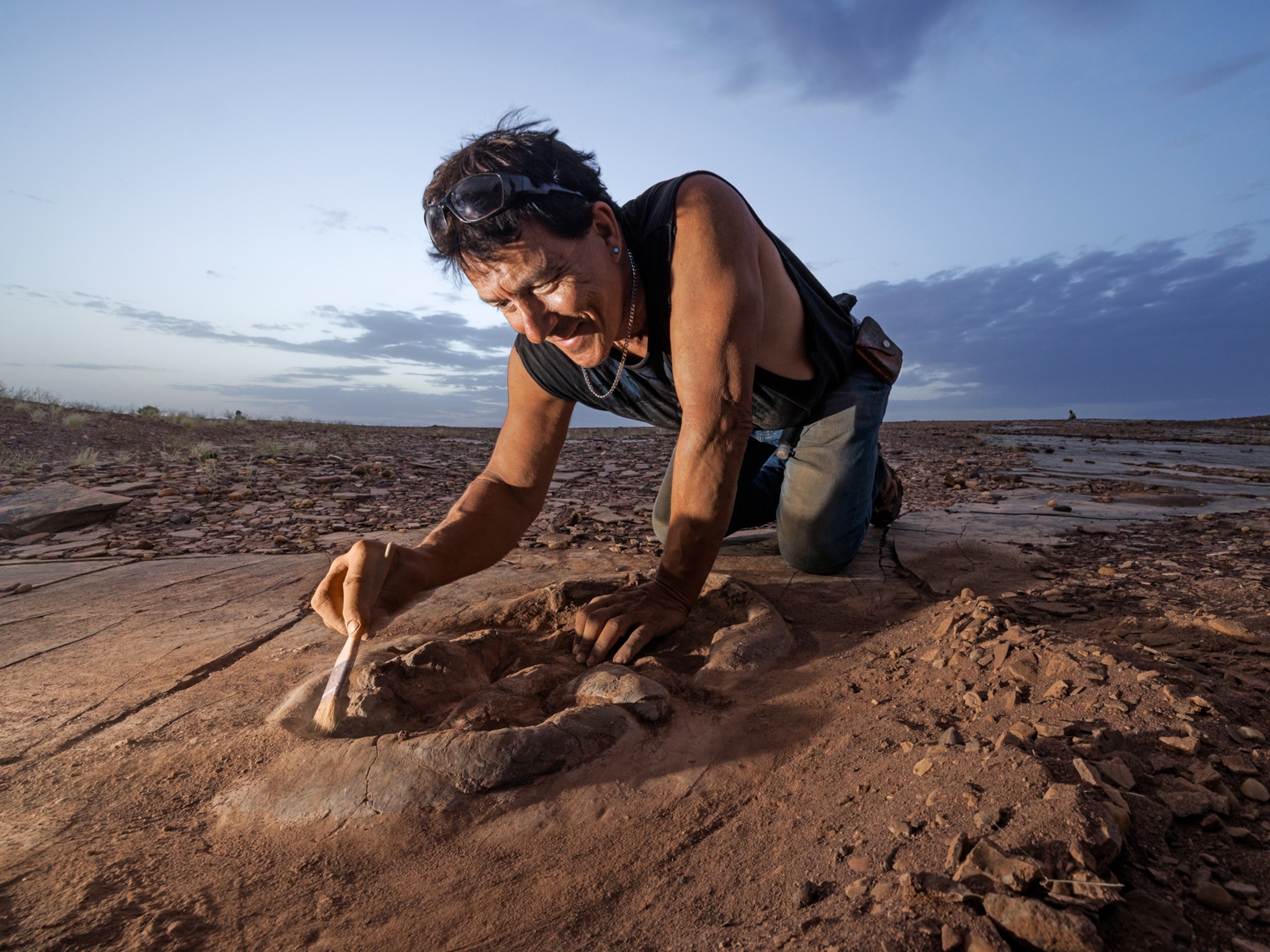
New clues reveal the devastation the day the dinosaurs died
Unusual traces found in Texas show what happened when the Chicxulub asteroid vaporized a thick bed of rock, unleashing superheated gas that kicked off a calamitous period of climate changes.
Tiny flecks of white dot a section of crumbly rocks along Texas's Brazos River. To a casual observer, the grains may seem like unremarkable bits of sand, but within their oddball shapes lie clues to the most catastrophic day in our planet's history.
Some 66 million years ago, a six-mile wide asteroid slammed into the ocean off the coast of Mexico’s Yucatán Peninsula, carving out a 110-mile wide crater known as Chicxulub. In an instant, the trajectory of life on Earth was forever changed. The impact kicked off wildfires and tsunamis across thousands of miles. Then swings in global climate—a dramatic period of cooling followed by a long period of warming—ushered in the extinction of some 75 percent of all species, including the non-avian dinosaurs.
Now a study published in the journal Geology uses the tiny white specks in Texas, known as lapilli, to reveal intriguing new details about what happened in the minutes after that fateful impact: The asteroid struck with so much power it instantly vaporized a thick bed of carbonate rocks below, sending a superheated gaseous plume billowing upward along with a curtain of rocky fragments blasted from the surface.
The lapilli formed somewhere in this geologic jumble of vapor and dust and then rained down on what is now Mexico, Belize, Texas, and even New Jersey. "They're forming in essentially an instant of time," says Gregory Henkes, a geochemist at Stony Brook University in New York and author of the new study.
A chemical analysis revealed that the lapilli formed when temperatures soared to some 311 degrees Fahrenheit, hinting at a zone of devastation that reached more than a thousand miles from the crater's center within minutes, the team writes in the study.
The lapilli may also hold clues to how much carbon dioxide remained in the atmosphere after the impact, which eventually caused a period of global warming that continued, by one estimate, for as long as 100,000 years. The ancient ripples through Earth's ecosystems from this climactic shift remain relevant today.
Humans are essentially "running our own experiments" as we pump greenhouse gasses into the sky, notes Brandon Johnson, a planetary scientist at Purdue University who was not part of the new study. "If we can understand what it did 66 million years ago, we might be able to better understand what it can do today."
Chemical thermometers
The lapilli analyzed in the new study were collected in the 1990s from a small outcropping of rock in central Texas along the Brazos River. The tiny bits of rock have since posed many mysteries, including how they formed in the first place.
Lapilli are well known in deposits from some types of volcanic eruptions, where they grow in the ash plumes as clumps of glassy fragments get bound together by water. "It's actually kind of similar to how a hailstone might grow," Johnson says.
Lapilli are also found around some impact craters, but whether they form the same way is less clear. Analysis of carbon and oxygen isotopes in the new study provides support for one previously suggested mechanism: The condensed gasses from the vaporized carbonate rocks may act like lapilli glue, holding the tiny clumps together. Johnson and a colleague suggested a similar mechanism behind the formation of lapilli on the moon, where water is scarce.
In addition, bonds between the heavy isotopes of carbon and oxygen become more scarce at higher temperatures. Using this fact and a method known as clumped isotope analysis, the scientists were able to take the temperature of the cloud of gas that dissipated millions of years ago, explains the study's first author David Burtt, a Ph.D. candidate at Stony Brook University.
One challenge with this analysis is confirming the lapilli weren’t later altered, such as through heating from deep burial, which would have obscured their recorded temperatures. So the researchers also analyzed the carbonate shells of tiny marine animals known as forams that were preserved around the same time nearby. The heavy bonds of the forams were in line with expected sea surface temperatures from that time period, suggesting that the lapilli temperatures had also been preserved.
The results indicate that the tiny flecks of rock formed at a sizzling 311 degrees Fahrenheit.
"For the biosphere, this is going to be devastating," says geochemist Steven Goderis of the Vrije Universiteit Brussel who specializes in impact craters but was not part of the study team.
Working out exactly how far this gassy inferno spread from the impact site has been a challenge. Researchers have long debated the exact angle and direction of the asteroid as it slammed into the surface, which would help determine the areas that were most intensely blasted by the ejected material. Goderis notes that the study of additional lapilli in Mexico could help researchers better understand variations in the spread of temperatures. But curiously, Goderis says, lapilli aren't found in all areas around the impact crater, and scientists aren't sure why.
Another unknown factor is when and where along the impact trajectory the lapilli formed, notes geologist David Kring of Lunar and Planetary Institute, who has done extensive work on the Chicxulub impact site. "I'm hoping these types of studies will eventually take us to that point," says Kring, who was not part of the study team.
The fireball that changed the world
Past models have suggested the impact caused even higher atmospheric temperatures. Thus the high temperatures of the lapilli formation are, in some ways, not surprising.
"What's new is they have actually pinned a temperature on a particular type of object," Kring says.
Some estimates suggest the incandescent gasses released by the impact formed an expanding fireball that radiated so much heat, it ignited wildfires as far as 1,500 miles away. Temperatures are thought to have crescendoed as the blasted bits of debris fell back to Earth. As the material went "screaming through the atmosphere," Kring says, it superheated the air and broiled wide swaths of land.
Around the impact site, the temperatures would have been high enough to cause plants to spontaneously ignite. Debris also circled the planet, concentrating on the opposite side of the world where it likely sparked similar fires.
Burtt and Henkes both see the new study as a jumping-off point. One important point for future study involves the pulse of carbon dioxide that was released when the asteroid vaporized a large amount of carbonate rock.
The lapilli formation within the cloud of vapor would eat up some of this carbon dioxide, perhaps influencing the global climate shifts in the years after the asteroid struck. The mix of emissions from the impact—including sulfur, carbon dioxide, and water vapor—sent the world on a wild swing from chilling to warming, which collapsed food webs and sent countless species spiraling toward extinction. Studying how much of these climate-impacting gasses were released is important to fully understand what killed off so many species—something scientists are still figuring out, Johnson explains.
And this aspect of the story isn't all ancient history. "There is an anthropogenic extinction-level event happening right now," Henkes says, referring to the dramatic declines in biodiversity that humans have caused by releasing greenhouse gasses, changing land usage, introducing invasive species, and more.
The current changes are not as sudden as an asteroid impact, he says, but the effects will echo through the biosphere for millennia.








